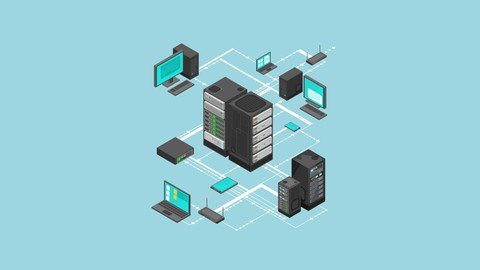
Last updated 3/2018
MP4 | Video: h264, 1280x720 | Audio: AAC, 44.1 KHz
Language: English | Size: 575.31 MB | Duration: 5h 41m
Grasp the skills to automate your infrastructure efficiently
What you'll learn
Learn more about web performance and load testing usage scenarios
Use load tests for different types of testing including smoke, stress, and performance
testing
Create, run, and edit a load test
Edit load tests using the Load Test Editor
Execute load tests using the Load Test Service
Create agent pools and queues and understand the TFS 2017 build infrastructure
Install build agents to demonstrate it to the viewers
Run tests as part of your build to familiarize yourself with load tests
Run multiple concurrent builds to run more builds
Demonstrate and configure Continuous Integration (CI)
Use build tasks to deploy your application components
Requirements
Basic knowledge of Team Foundation Server is needed
Description
Team Foundation Server (TFS) is a collaborative software development tool by Microsoft that provides automated builds, testing and various other features. So, if you're a software professional who want to explore the automation features of TFS, then go for this Learning Path.
Packt's Video Learning Paths are a series of individual video products put together in a logical and stepwise manner such that each video builds on the skills learned in the video before it.
The highlights of this Learning Path are
Use the Web Performance Test Results Viewer to create and run a web performance test
Create a new build definition and configure a build task
Let's take a quick look at your learning journey. You will start with the web performance and load test for different types of testing. You will then move on to understand how to configure and run web performance tests. You will then see how to create and execute load tests. Next, you are going to explore the build features in TFS. You will setup and configure the environment that will be able to run Windows and non-Windows builds. Once you have seen how to author build definitions, you will take a closer look at builds. Finally, you will look at the many ways to customize and extend the builds as well as other features and enhancements.
On the completion of this Learning Path, you will be well versed with the automation features available in the Team Foundation Server.
Meet Your Expert
We have the best works of the following esteemed author to ensure that your learning journey is smooth
Paul Hacker, a Principal Consultant with AgileThought, has over 15 years of application architecture, design, development, and management expertise in Microsoft technologies. He has a depth of experience in ALM, Process Improvement, and Team Foundation Server. Having distinguished himself as a leader in the IT industry he has been awarded the distinction of Microsoft MVP in the ALM category every year since 2006
Overview
Section 1: Test Automation Features in TFS
Lecture 1 The Course Overview
Lecture 2 Overview of Web Performance and Load Testing
Lecture 3 Web Performance and Load Testing Usage Scenarios
Lecture 4 Using Load Tests for Different Types of Testing Including Smoke, Stress, Perform
Lecture 5 Creating and Running a Web Performance Test
Lecture 6 Using the Web Performance Test Results Viewer
Lecture 7 Editing Web Performance Tests
Lecture 8 Creating and Running a Load Test
Lecture 9 Analyzing Load Test Results
Lecture 10 Editing Load Tests Using the Load Test Editor
Lecture 11 Using Coded UI Tests in Load Tests
Lecture 12 Executing Load Tests Using the Load Test Service
Section 2: Build Automation Features in TFS
Lecture 13 The Course Overview
Lecture 14 Understanding the New 2017 Build Infrastructure
Lecture 15 Creating Agent Pools and Queues
Lecture 16 Installing Build Agents
Lecture 17 Specifying Capabilities on Your Build Agents
Lecture 18 Configuring Security
Lecture 19 Overview of Non-Windows Build Agents
Lecture 20 Hybrid Environments
Lecture 21 Creating a New Build Definition
Lecture 22 Understanding Build Templates
Lecture 23 Selecting the Solution to Build
Lecture 24 Running Tests as Part of Your Build
Lecture 25 Queuing a Build
Lecture 26 Selecting Our Source Repository
Lecture 27 Running Multiple Concurrent Builds
Lecture 28 Working with Build Variables
Lecture 29 Configuring Continuous Integration
Lecture 30 Using Gated Check-Ins
Lecture 31 Using Capabilities to Influence Agent Selection
Lecture 32 Build Retention Policies
Lecture 33 A Lap Around the Available Build Tasks
Lecture 34 Using Build Tasks to Deploy Your Application Components
Lecture 35 Extending Builds Using Scripts
Lecture 36 Viewing Build Status
Lecture 37 Controlling Build Outputs and Understanding Artifacts
Lecture 38 Packaging Your .NET Application
Lecture 39 Examining Test Results from a Build
This Learning Path is targeted at software professional who want to explore the automation features of Team Foundation Software
Homepage
https://www.udemy.com/course/learning-path-automation-with-team-foundation-server/Download From 1DL
https://1dl.net/ve8l6p7ame0z/cfsgc.Learning.Path.Automation.With.Team.Foundation.Server.rar

https://rapidgator.net/file/5a56cdb8430c0914baabf7915ae3c85e/cfsgc.Learning.Path.Automation.With.Team.Foundation.Server.rar.html

https://uploadgig.com/file/download/926D12B9dea312f4/cfsgc.Learning.Path.Automation.With.Team.Foundation.Server.rar

https://nitroflare.com/view/7D65C38AB5D2803/cfsgc.Learning.Path.Automation.With.Team.Foundation.Server.rar
